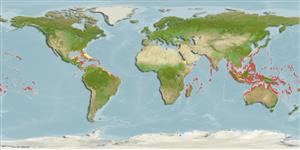Common names from other countries
Environment: milieu / climate zone / depth range / distribution range
Écologie
; profondeur 0 - 20 m (Ref. 4). Tropical; 33°N - 36°S, 97°W - 135°W (Ref. 4)
Distribution
Pays | Zones FAO | Écosystèmes | Occurrences | Introductions
Indo-Pacific and Western Atlantic.
Length at first maturity / Taille / Poids / Âge
Maturity: Lm ? range ? - ? cm Max length : 20.0 cm TL mâle / non sexé; (Ref. 4)
It has lengths of 20 cm, maximum total length; between 2 and 9, carapace length (Ref. 4). Taken at depths from 0 to 20 m, in coral or stone reefs with a sandy bottom. It is nocturnal and in the daytime hides in crevices, sometimes in small groups (Ref. 4). Also on rubble (Ref. 97531). Scyllarids are commonly considered to be opportunistic omnivorous (Ref. 106411). Aquarium observations indicate that they may open bivalves (Ref. 102680).
Life cycle and mating behavior
Maturité | Reproduction | Frai | Œufs | Fécondité | Larves
Members of the order Decapoda are mostly gonochoric. Mating behavior: Precopulatory courtship ritual is common (through olfactory and tactile cues); usually indirect sperm transfer.
Holthuis, L.B. 1991. (Ref. 4)
Statut dans la liste rouge de l'IUCN (Ref. 130435)
statut CITES (Ref. 108899)
Not Evaluated
Not Evaluated
Utilisations par l'homme
Pêcheries: commercial
| FishSource | Sea Around Us
Outils
Plus d'informations
Taille/Âge
Croissance
Longueur-poids
Longueur-longueur
Morphologie
Larves
Abondance
Sources Internet
Estimates based on models
Preferred temperature
(Ref.
115969): 25.6 - 29.3, mean 28.1 (based on 3695 cells).
Vulnérabilité
Low vulnerability (10 of 100).
